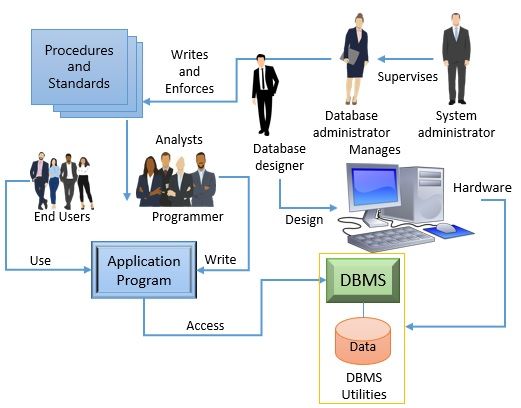The database system environment is comprised of the components that are meant for defining and managing the data that we collect, store, manage and use in the database environment. In the section ahead, we will discuss all the components that constitute the database environment and along with this, we will also discuss the system utilities that are used to control and manage the database.
Components of Database System Environment
Every system environment is made up of certain components that help the system to get organized and managed. Even the database system environment is made up of the following components:

1. Hardware
The hardware component of the database system environment includes all the physical devices that comprise the database system. It includes storage devices, processors, input and output devices, printers, network devices and many more.
2. Software
The software component of the database environment includes all the software that we require to access, store and regulate the database. Like operating systems, DBMS and application programs and utilities. The operating system invokes computer hardware, and let other software runs. DBMS software controls and regulates the database. The application program and utilities access the database and if required you can even manipulate the database.
3. People
If talk of the people component then it will include all the people who are related to the database. There may be a group of people who will access the database just to resolve their queries i.e. end-user, there may be people that are involved in designing the database i.e. database designer.
Some may be involved in designing the applications that will have an interface through which data entry is possible i.e. database programmer and analyst and some may also be there to monitor the database i.e. database administrator.
4. Procedures
The procedure component of the database environment is nothing but the function that regulates and controls the use of the database.
5. Data
Data component include a collection of related data which are the known fact that can be recorded and it has an implicit meaning in the databsae.
System Utilities
Database system utilities are the tools that can be used by the database system administrator to control and manage the database system.
1. Loading Utility
Loading database utility helps in loading the database file into the database. It efficiently reformats the current format of data files to the format that is required by the destination database file structure. Some loading programs or tools are specially designed for loading data from one DBMS to another.
If you provide source database storage description and target database storage description to these loading tools then it will automatically reformat the data files to target database storage description.
2. Backup Utility
The backup utility in the database environment helps in creating a backup copy of the entire database. Generally, the entire data of the database is copied to mass storage and we refer to it as a backup copy. This backup copy can be used when there is a system failure or storage of your system is corrupted.
You can always choose incremental backups which only record the changes from the previous backup. Though the incremental backup requires a more complex algorithm it saves more space as compared to regular backup.
3. Database Storage Reorganization Utility
Sometimes we need to relocate the set of database files to a different location. The database storage reorganization utility helps to relocate and organize the database files to a different location and it also produces a new access path to access the files from its new location.
4. Performance Monitoring Utility
Performance monitoring utility monitors the usage of the database by its user and provides statistics for the same to the database administrator (DBA). The statistics provided by the utility helps the DBA to decide whether it is required to reorganize the data files, whether there is a need to add new indexes or not, whether some indexes to the files must be dropped to improve the performance of the database system.
There are more utilities in the database environment that help in sorting the database file on some basis, handling data compression on the large databases, monitoring the user’s access to the database and many more.
So, this is all about the database system environment. We have learnt about all the database system component that constitutes the database system environment. We have also learnt about the system utilities that can be used to manage the database system.

Leave a Reply